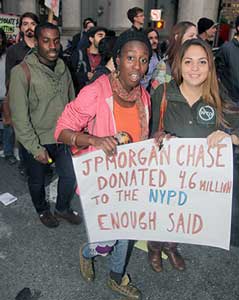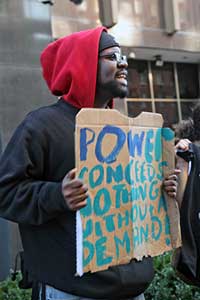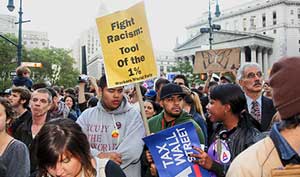Occupy Wall Street leaps to new level
Oct. 6 — The police have once again proved to their bosses at JPMorgan Chase and Goldman Sachs that they can be relied upon to bust heads to protect Wall Street.
 New York, Oct. 5. WW photos: G. Dunkel |
A police riot last night, in which protesters against Wall Street were clubbed and arrested, must be added to the long list of reasons the New York Police Department should be shut down. These include spying on the Muslim community and occupying Black and Latino/a communities.
Just three nights ago, New York cops shot and killed a homeless person outside the New Providence Residence, a substance abuse shelter for women. The reason? She had a knife, they said.
Once again the ongoing police attacks on righteous protests against corporate greed and unemployment must be condemned.
It would be a mistake for the latest police attack to obscure the monumental tipping point solidified yesterday by the Occupy Wall Street movement. It decisively expanded its power and influence by marching with thousands of workers from major unions.
 |
Students from at least a hundred college campuses around the country walked out of class to protest continuing tuition hikes, even as tens of thousands of people were marching in the streets of New York against austerity and Wall Street criminals.
This moment might best be described by the famous statement attributed to V. I. Lenin, leader of the 1917 Russian Revolution: “There are decades where nothing happens; and there are weeks where decades happen.”
A dialectical turning point
This quote is not just a clever description that happens to fit the moment. It is a perfect Marxist explanation of the unfolding occupy movement. It is an explanation of the way true change happens, according to the laws of dialectics.
Dialectics is an academic-sounding word meaning the science of change — or more accurately, the science of development.
 |
One of the laws of dialectics is that everything is in a constant state of change, even if it looks like it’s standing still. The change becomes visible when a qualitative point is reached.
This is true of any inanimate object — even if it’s just sitting there, it may be rusting or decomposing — and it’s also true of society.
In other words, while it has seemed for a long time that things were getting worse and worse under capitalism with no relief in sight, in actuality things were bubbling under the surface until they erupted into the political landscape we see now.
Just this Sept. 17, Occupy Wall Street was an encampment of maybe a hundred people sleeping in New York’s Zucotti Square, with no formal demands and vague leadership.
 |
Today the movement has spread like wildfire, with occupations or Wall Street-focused protests in more than 160 U.S. cities. Chicago’s occupation has just completed its second week. Thousands are expected to march today in Los Angeles. Occupy Madison, Wis., home of the gigantic pro-union demonstrations this spring, begins today.
Probably the most dynamic feature of the occupy movement has been its rapid embrace by so many sectors of society. Students, unions, community groups, people of color, LGBTQ people, the unemployed — thousands have been activated to protest.
Yesterday, members in New York City of 15 of the country’s largest unions — as well as students who walked out of classes at New York University, the City University system, Columbia University and the New School — joined the huge “March in Solidarity with Occupy Wall Street.”
Earlier this week, the Transport Workers Union took a bold stand, filing suit against the NYPD’s commandeering of city buses to ferry masses of arrested protesters. This police practice includes ordering passengers off buses — as if public transportation hasn’t been cut back enough.
 |
In Boston yesterday, Northeastern University students blocked Atlantic Avenue and held a standoff with police. Three buses carrying several hundred nurses from the Massachusetts Nurses Association joined the protest.
Hundreds of State University students in many upstate New York campuses walked out of class.
The last four years’ acceleration of layoffs, foreclosures and looting of pensions came after decades of layoffs, cutbacks, the growth of the prison-industrial complex and the destruction of the socialist camp. This period of reaction could not go on indefinitely.
It was literally only a matter of time before the people rose up again. While it might be tempting to compare this movement with that for civil rights in the 1950s, which inspired the student, Black, gay and women’s liberation uprisings of the late 1960s and early 1970s — the last time this country saw a sustained movement that challenged the status quo — the crucial difference this time is the unemployment crisis.
On Sept. 29 a CEO association called Business Roundtable released the results of a survey of 140 executives. Of those surveyed, the number planning job cuts had more than doubled since the second quarter.
The capitalist crisis has created a movement for which the capitalists have no solution. The eruption of protest nevertheless demands a solution. And this has put the question of socialist revolution squarely on the table.
Workers World, 55 W. 17 St., NY, NY 10011
Email: ww@workers.org
Subscribe wwnews-subscribe@workersworld.net
Support independent news DONATE
